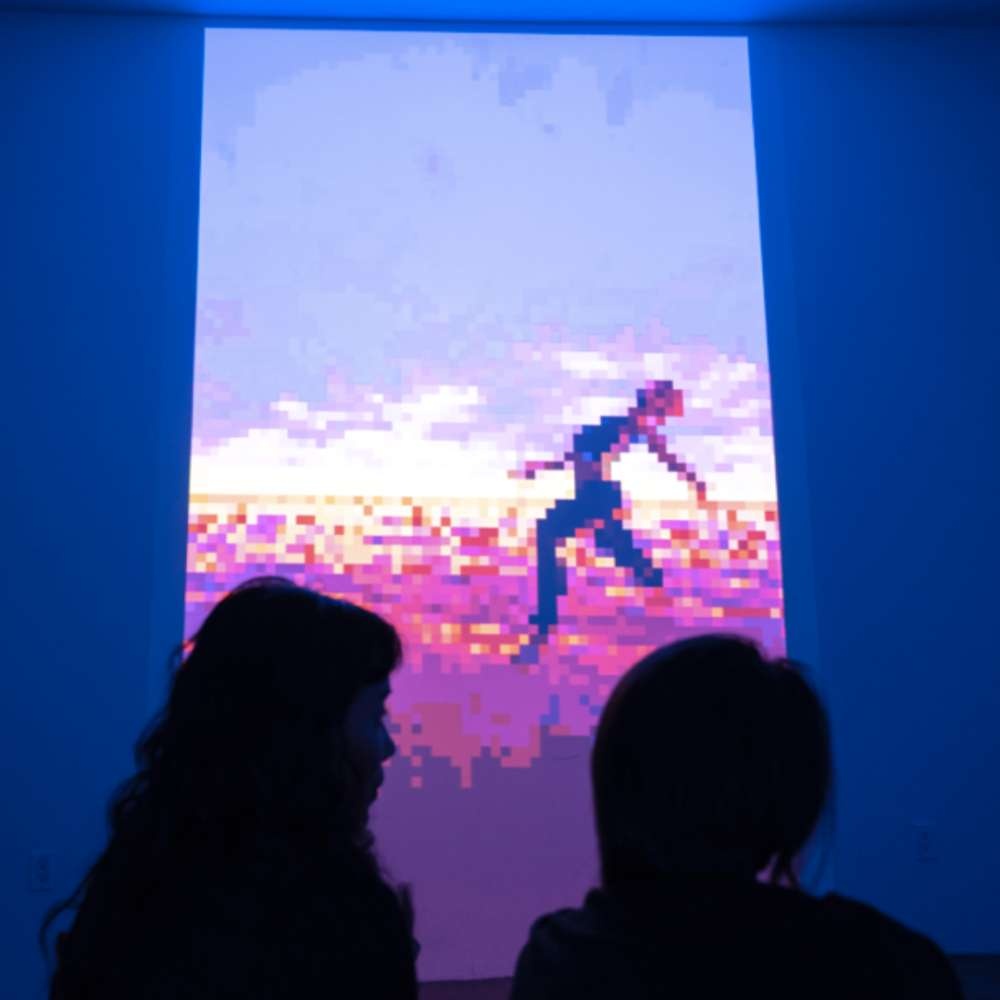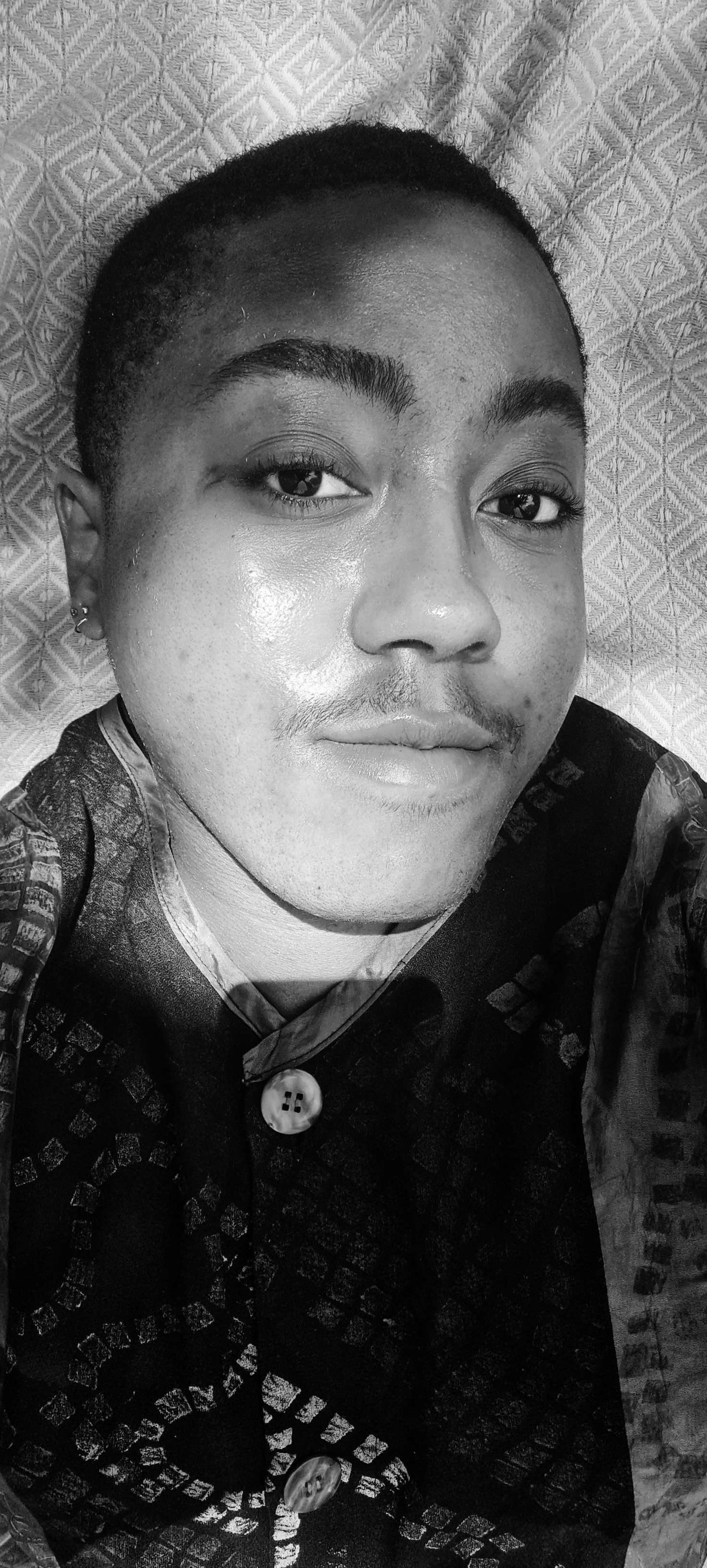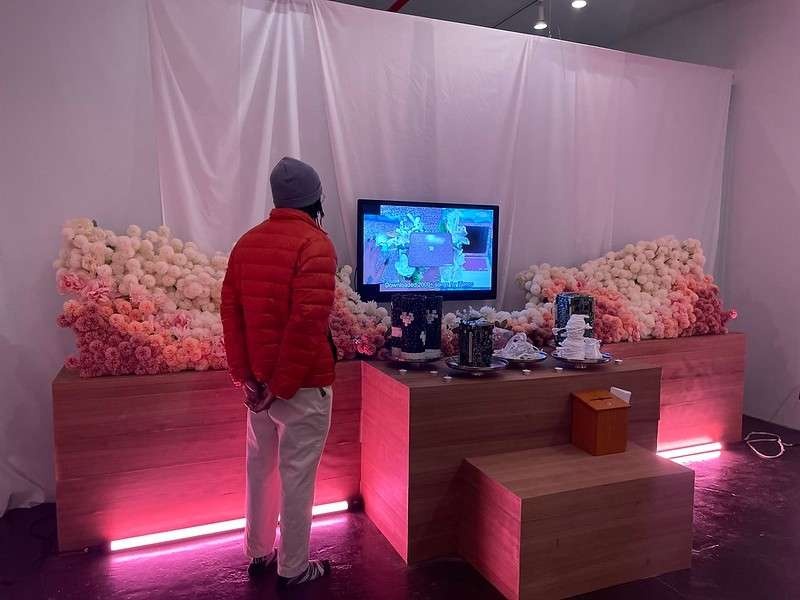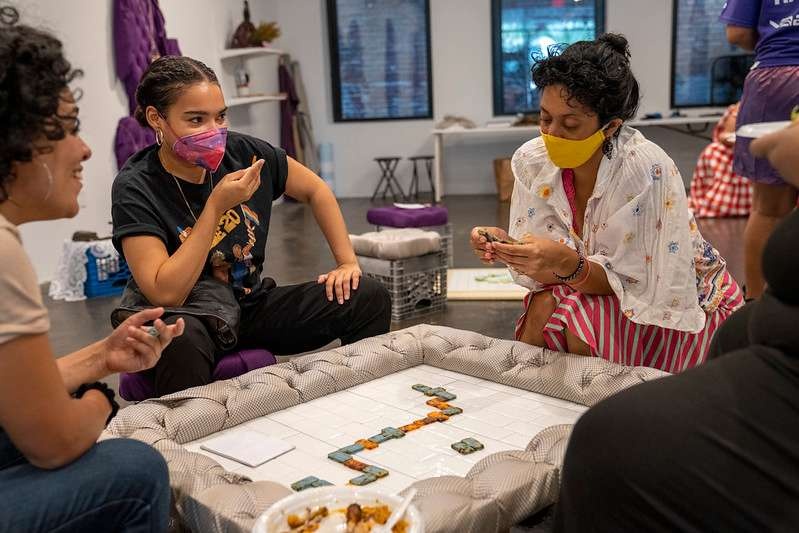A Subtle Shift: Suggestions on Liberated Practice in LaJuné McMillan's Black Movement Library
Imani Ford
Dear LaJuné,
I have unconsciously stepped onto the wheel of what feels like an ongoing process. One that stages, quite subtly, the reproduction of blackness and what remains when our bodies touch and then leave space. I see the wheels of the Black Movement Library (BML) turn as blackness does its next iteration of liberatory practice. I have witnessed two iterations of BML: the first at the Brooklyn Public Library in the summer of 2021 and the second this fall at Recess. According to you, “BML is a library for activists, performers & artists to create diverse XR projects, a space to research how and why we move, and an archive of Black existence. BML seeks to grow the community through the use of performances, xr experiences, workshops, conversations, and tool making.” Such a liberatory practice requires both conscious and unconscious refinement of our methods of moving and thinking, which requires paying attention to the tools we acquire, wield, meld, and create to forge our sense of the next moment.
The library is not only home to objects chosen, selected, and defined by their categorization but a space to learn and seek answers to questions known and unknown to us. The library is a site for learning, thinking, and knowledge production. Its critical possibility, to my mind, is contingent upon the objects it houses and how said objects are categorized into objects of study.


Visitors at the opening reception of Black Movement Pop Up Library
BML thinks through the very relationship between objects and objects of study. At the Brooklyn Public Library, you shared “Movement Portraits” which consisted of some of your library’s contents and performances that allowed us to watch the process of your archive’s expansion. “Movement Portraits” consists of multiple parts: pre-recorded interviews of your dancers and the vr portraits generated while the dancers perform in the motion witness technology. The pre-recorded interviews were exhibited and projected onto either side of the building before the performances. In them, the performers share their stories of dance, life, and existence before they took the stage to perform. Strapped into technological sensors, they improvised their VR “Movement Portraits” which look like symbiotic, ever-changing digital, abstract paintings projected onto the library’s facade. I watched as their movement data was translated into the projected visuals in real-time. Your “Movement Portraits” allowed the audience to multidimensionally witness blackness through three realities: virtual, experiential, and embodied.
When staged at Recess, BML contained VR headgear; a curated display of academic texts on race, blackness, dance, and technology; meditation cushions; softly glowing cubes that warm space; and a large shaggy purple rug. We opened the space with intimacy—meditation, inner child journaling, vulnerability, and collaborative and improvised movement exercises. I sat and listened as you and others closed the space with discussions on the future of your work, being black while learning and teaching in academic spaces, and what it means to take, make and hold space to produce knowledge. You also held space online where we meditated, journaled, moved together, and listened to you engage Asmaa Walton & Ola Ronke of the Black Art Library and The Free Black Women’s Library on the Future of Black Libraries.


Visitors watch a Movement Portrait created by Session artist LaJuné McMillian
Your library at Recess suggests an abundant possibility for what might take place or occur within the library space as a political, social, and intellectual space. Your library dares to become a community space that involves dancing, eating, laughter, discussion, movement, and more. Witnessing a circle of folk—photographers, dancers, academics, curators, spiritualists, activists—share, imbibe, and translate one another’s embodied reality after sitting in meditation and sharing energy, intimacy, and care, forced me to confront the difficulties (and resulting grief) I experienced navigating libraries and other institutions of learning and knowledge production as a neurodivergent, black, queer, trans, first-generation, low-income student and teacher.
Your library offers a rubric for healing our relationship with libraries and other learning institutions. Throughout the history of blackness, libraries have simultaneously been spaces of refuge, radical thinking, containment, and disenfranchisement for black folk. This violent entanglement throws into sharp relief the problematic and often contradictory logic of a black liberation practice rooted in reading practices only. I have seen this rhetoric emerge in the hallowed halls of the academy, where learning spaces sterilize rather than invite the embodied witnessing that BML suggests black liberation and radical thinking entails. (And we have all seen it in many of the schools we frequented in the US as children.) By practicing reading alongside movement, we give space for us to experience language through our memory, our core, and our flesh. The customary classroom, seminar, and library posit a normative, white-facing conception of intellect. These contexts often normalize rigidity and uniformity as the foundation of thinking and knowledge production. In most instances, blackness remains an object of study, something to be looked at, examined, and translated rather than felt, expressed, and participated in. I felt these environments dull my senses by forcing me to codify and contain my thinking for a false sense of safety. My body—including the resulting injury I experienced from sitting and reading without movement for long hours—told another tale. We have all sought (and perhaps you understand this) healing from the initial wounding that was attempting to learn and exist in not only elite learning institutions but also the US education system. I slowly began to rely on witnessing black thinking, living, and embodiment outside of traditional learning spaces to do the work, for me, of black liberation. I took flight from the customary classroom to put theory into practice. I knew that learning, and engaging might be more, might feel more aligned with my being, and my spirit. And your library offers a space to read together, communicate with one another, move together, and the possibility of more.


Visitors watch a VR piece created by Session artist LaJuné McMillian
BML creates a library that is a practice. And your practice emphasizes liberation, which in itself is a political process that requires movement, experimentation, and change. BML highlights what libraries can be and allow space for, and how we might allow ourselves to move within them to liberate ourselves. Motion witnessing—your method for gathering, processing, and archiving black movement—reveals the political underpinnings of the omnipresent definition of the library as merely about how we archive, what we archive, and how we place objects amongst and in relation to one another matters. Instead, you gather equipment, machines, computer applications, people, their movements, and their stories to witness rather than capture what matters. By treating each like objects amongst other objects, you reassemble the very meaning of (what) matter(s).
Your library’s emphasis on blackness and movement reassigns meaning to objects often used as technology—to produce scientific knowledge by capturing, cataloging, and categorizing data—by using them as tools (or things) for liberating black movement from colonial, visual, and technological capture. You are not using technological objects to look at us, examine us, and then ask yourself, “What are they?”You are using technological objects to archive our knowledge–memory, stories, movement, etc–by asking us “Who are you?” You name the object—the image-idea of The Black Body—that haunts that colloquial definition of the library, the object that haunts western intellectual and learning spaces. Your decision, however, to use technological objects to archive black embodiment, movement, and dancers’ interior experience erodes technological objects’ extractive, scientific mechanisms of extracting our labor and our knowledge from our bodies.
You have stated that the MakeHuman, Mixamo, CMU’s motion capture database, and other motion capture technologies, lack the tools to “create diverse characters and movements unexplored by systems that center assumptions of neutrality.” You, therefore, employ objects that are limited in their scope to witness that which you seek to hold sacred: blackness. You take technologies that cannot quite witness the full extent of your performers and their movement to witness what these technologies can discern as well as the glitch in which they cannot. You are comfortable with, if not satisfied by, the technology’s inability to perfectly witness black embodiment. The technology picks up black movements but cannot quite hold black embodiment; that tangibility of blackness is inevitably enfleshed. You create beautiful, whimsical, and ethereal virtual worlds that imagine and figure black embodiment in worlds that are fluid and shifting–quite similar to BML, a library for black people to experience being with one another and amongst a host of other things.
BML suggests that black embodiment is a form of black radical thinking and knowledge production that is necessary, if not central, to black liberation practices. Black movement is the, most often improvised, energetic gestural that catalyzes black embodiment, making blackness available to the felt sense. BML provides spaces to intuit, meditate, and be with blackness by exchanging energy through black life. The space to collectively witness blackness amongst ourselves and with each other suggests that black liberatory practice incubates when we pause, exist, vibrate, love on, and meditate with the felt experience of blackness together. At Recess, my senses were ensnared. I saw movement, light, darkness, and contrast; a dancing black person’s movements transported through sensors into another world of you and your collaborators’ making. I touched a black stranger in my embrace. I sat, barefoot, running my fingers through a fluffy purple rug. I tasted Jerk egg rolls and other alchemical mixtures. I heard the stories of your dancers and listened to Ntu’s music as the “Movement Portraits” played. I heard laughter, discussion, anger, grief, hope, softness, and care. I smelled warmth in the midst of fried treats. Simultaneously, I embraced a stranger I seemed to know, and who seemed to know me. I felt my own anger, grief, hope, softness, and care. I listened to myself as I wrote and meditated with my inner world alongside yours and our interlocutors. I remembered things about my small self I thought I lost. I recognized a loss I may never find again. I felt them come up and out of my gut as I shared my movements and reinterpreted yours. And I dreamed, eyes wide open, of what BML–vis-a-vis blackness–might say about the possible existence of black intellectual spaces that could hold all of me. I witnessed and felt that liberation comes into view, nascent and titillating when blackness reveals itself through all of the senses. We must not only conjure black life, we must live it, love it, and be it. A black intellectual space that would hold, and embrace me would be in the world, moving as freely and uninhibited as I dare to with black folk. It is a movement with the intention of building a truly loving, healing, and collaborative community. And this work must span beyond academia and centralize learning and cultural spaces embedded within our communities. We must work, live, think, and love together.
An Interlocutor,
Imani (they/he)
Author
Imani Ford
Artist


Imani Ford (they/he) is an interdisciplinary artist, healer, and teacher born and raised on the South Side of Chicago. He now lives and makes art in Harlem where they also teach mindfulness-based, trauma-informed art classes to help heal their students’ nervous systems.
Projects
Explore/Archive
See allNovember 2023
Flowers to Seeds: Tilling the Dreamscape in AYDO’s Offering of Dreams
Alison Guh
written in conjunction with artist duo AYDO's Session project, Offering of Dreams.
September 2023
Chinyere Okafor
written in conjunction with artist Suhyun Choi's Session project, Memorial for Laptop.
June 2023
Everyday Objects, Complicated Histories
Kleaver Cruz
written in conjunction with artist Francheska Alcántara's Session project, Secure the Bag, Mint the Soaps and Throw the Bones.





